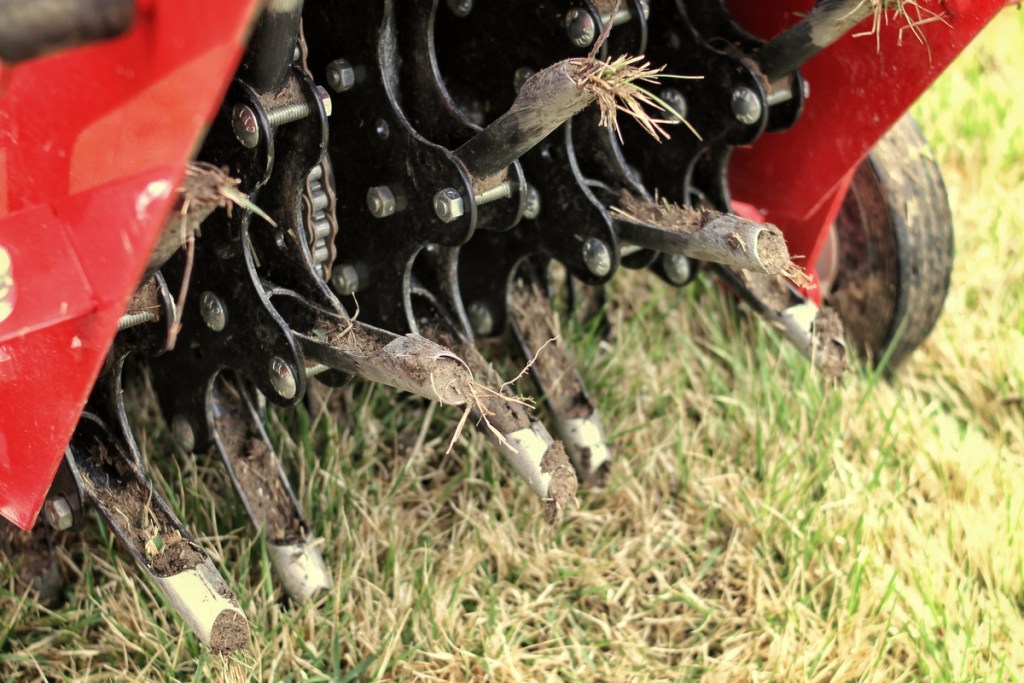When your grass starts growing unevenly, thinning out, or changing color, such as turning yellow, it very likely means it needs aeration — even if you’re feeding it regularly. Unsightly symptoms can occur when you have tightly compacted soil because neither the roots nor the water can penetrate it. Core aerating may sound like a miracle cure for your lawn, but it can do wonders. Keep on reading to learn more about this process and when to aerate your lawn.
How does an aerator work?
There are several kinds of aerators, but the hands-down best results come from core aerators. A core aerator is a heavy roller covered with hollow spikes that roll across the grass to pull soil plugs from the lawn’s root zone. The sheer weight of the roller drives the spikes through layers of thatch, dense roots, and compacted soil. It pulls 3/8 inch diameter plugs, up to 3/4 inch deep or more.
The aerator functions best on damp soil. Hard, dry soil may be impervious even to the machine that’s supposed to fix it. While you might be able to fix this by lightly irrigating several times per day for a week to soften the soil, a better solution would be to aerate after a significant stretch of wet weather.
What does aeration do?
If your grass looks bad, aeration could be one of the keys to bringing it back to good health. Hardpan soil resists water penetration and deep root development. Some grasses adapt to this condition by forming a dense layer of shallow roots, rhizomes, and stolons at the soil surface, better known as thatch.
Aerating the lawn addresses thin and bare spots associated with soil compaction, and it helps correct thatch buildup caused by shallow rooting. Aerating the lawn loosens the soil surface and breaks up the thatch layer, which fosters deeper root development. It also lets water and nutrients penetrate deeper.
How do I know if my lawn needs aeration?
Lawn aerating shouldn’t be viewed as a routine maintenance activity. Aerating the lawn when it isn’t necessary weakens the grass and could lead to pest or disease problems. Instead, watch for indications of compact soil, such as worn areas, puddling, thin or dead patches, discolored grass, uneven growth, or thatch buildup. Any one of these symptoms could indicate the need to aerate.
If you think your yard needs to be aerated, perform a screwdriver test. Using any type of screwdriver with a 6-inch blade, attempt to push it into the soil. If you meet with some resistance, it could be time to aerate. If you can’t push the blade into the soil all the way up to the handle, you should definitely aerate the lawn.
It would also be helpful to aerate before overseeding the lawn. Mow the grass low, then aerate the yard prior to applying lime, fertilizer, and seed. Doing so will help the grass seed stay put if it rains before germination. It also helps to promote healthy root development.

When should I aerate my lawn?
When you aerate the lawn, you sever many feeder roots and weaken the plants. It’s best to do this as the grass heads into a strong, rapid growth phase. Aerating too early or late in the year, such as during winter dormancy or summer heat and drought, stresses the grass at a time when it needs to conserve its resources. Poor timing of aeration could open the lawn to weeds, insects, or disease.
The best time to aerate a lawn is at the beginning of its rapid growth phase. For warm-season grasses like Bermuda grass and zoysia grass, that means shortly after it turns fully green in late spring or early summer. Cool-season grasses like tall fescue and Kentucky bluegrass are best aerated in either early fall or early spring.
Is aerating your lawn worth it?
Aerating the lawn is definitely worth the trouble and the expense if your lawn is in need of aeration. Lawns with the classic symptoms, such as thinning, discoloration, or uneven growth are likely candidates. It also makes sense to aerate before overseeding.
There’s no need to contract with a landscaping company to aerate every spring. Instead, add a lawn inspection to your to-do list each year. Pay close attention to worn areas, low spots where puddles form, discolored patches, and areas of uneven growth, and perform the screwdriver test as described above. If your lawn fails the screwdriver test, then it’s time to aerate your lawn.
Editors' Recommendations
- Plant these stunning flowering shrubs for a showstopping garden display this spring
- 3 incredible reasons why you should be using coffee grounds in your garden
- Have a gross mealybug infestation on your plants? Try one of these remedies
- These plants should be among the first you plant this year
- Unique and whimsical flowers to add to your collection for a fairy-tale garden landscape this spring







